 |
[December 31st 2005]
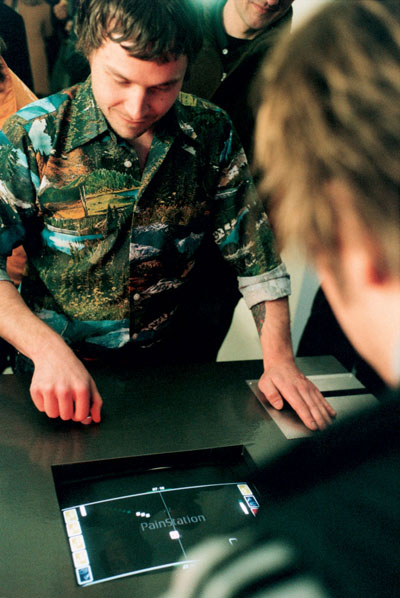
Painstation by Fur. Photo: Fur.
From an Artist's Pespective
Artist Mathias Fuchs continues Artificial's series on Art Games. In his terminology Game Art is the right word to use.
First ”Video killed the Radio Star”, then the interactive media made video look blunt, and now computer games seem to be more sexy than any other media ever has been.
The art community usually celebrates the advent of a new media with the proposition that:
1) artists have invented the media
2) that they know better what to do with the media and
3) that they can tell the future of the media
This happened with photography in the 19 th century, with William Henry Fox Talbot having coined the phrase "art of fixing a shadow" to describe his invention of the negative-positive photographic process in 1839. The technology of photography was turned into the art of photography. It happened again with video, Nam June Paik, Woody and Steina Vasulka amongst others, having been declared video pioneers. Video became video art. It happened once more with electronic music: The contemporary grandmasters of electronica couldn't help paying tribute to the early hisses and scratches of the likes of Pierre Henry and Pierre Schaeffer. Even Kraftwerk pointed out how important Karlheinz Stockhausen was for their music. Something very similar is going on in the world of computer and video games. There is a new beast out there, called game art.
I want to suggest in this essay that:
1) artists have not invented computer games
2) that they know better what to do with computer games and
3) that they can tell the future of games
Cannibalism
In the same way video art cannibalized television, and photography cannibalized painting, game art lives on the remainders of mainstream computer games. Cory Arcangel's ‘Super Mario Clouds v2k3' piece from 2002, is a hardware modification of the Super Mario game for the Nintendo NES console. Arcangel removed the main character, the friendly Italian plumber, and left the white clouds on blue skies to be watched by us. The artistic strategy of appropriation mixed with reduction is well known in other genres. Martin Arnold, an Austrian filmmaker based in the US today, took a similar approach to historic black and white movies when he removed characters from Hollywood film material to show backgrounds rather then main actors. In both cases, the artists spent enormous amounts of creativity, time and conceptual thinking on getting rid of what the original valued the most. Cory Arcangel had to become an expert in hardware modifications, and Martin Arnold had to learn and use a new software tool for months to rearrange the cannibalized material.
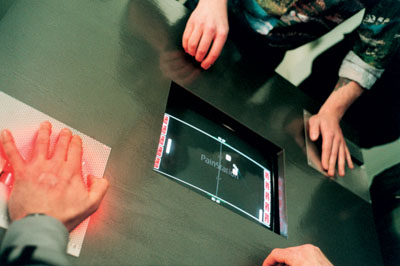
Painstation by Fur. Photo: Fur.
Let's look at another example: The PainStation by German game art group, Fur, is an ironic comment on the SONY PlayStation. Cannibalizing the Playstation name and trademark, it ironically comments on play and pain. The game console they designed contains a modification of the historic Pong game. The famous game where white paddles on a black background push a square ball, from one side of the computer screen to the other, has been set as a starting point for the Painstation set-up. The artists connected the scoring information of the simple game to electronic circuitry, making an electric current run through the player's hands. The level of voltage of the electric punishment increases with the score of the opponent. This playfully sadistic element of the game is accompanied by additional physical torture of the gamers. Apart from the entertaining aspects of the installation, Fur cleverly incorporates media history and game archaeology into their piece by cannibalizing forerunners of the genre. It is Atari's Pong and SONY's PlayStation which serve as a ferment of the innovative playstation game. Everybody understood the artistic reference and the pun on the PlayStation name, except for SONY Computer Entertainment Corp, who sued the artists for making improper use of their Logo. The artists somehow got away with it, they were forced, however, to change the typeface used for the PainStation in order to avoid ‘blurring the identity of the text-image brand'. Tilman Reif, one of the four artists, reports that in their reply to SONY they explained that they merely worked according to SONY's ‘go create' slogan, an idea which the marketing department obviously invented with little reference to the legal department's practice. In retrospective, one can be as happy as astonished about the fact, that Andy Warhol didn't run into problems with the Coca Cola Company and Campbell's Soups.
Hybridization
Media interact with each other and with elements of social and cultural fields with no respect to consistency or inner logic. So does media art. It has often been observed that television cross-bred with religion and advertisement, with furniture design and the food industry. TV-dinners and TV-preachers are bastards, not originating from media inherent logic, but from the ruthless desire of the television medium to reach out into foreign terrain. Mobile phones, which serve as torches or as alarm clocks do the same thing. Refrigerators made in the Loewy design and style, construct weird and irrational hybrids between a hot steam engine and a cooler to keep food cold. Game artists merge cultural fields in order to surprise their audience and in order to cast light on hidden relationships between seemingly unrelated fields. Margarete Jahrmann and Max Moswitzer's linX3D game consists of a modification of a 3D-shooter, which does two things at the same time: By shooting virtual enemies the user fires on targets in the game environment. At the same time the game also works as an email client. Whenever the user shoots an enemy, an email with a protest message is sent to the White House in Washington: Stop the War! Politically motivated mail functionality and shoot'em up fun is merged into one. The relationship between the two linked functions might seem arbitrary and unrelated, but for the artists these two functions belong to a wider network of social interaction and social activity related to each other. Hardware hybrids are another form of bastardisation. Ratio agendi #3 – Pong, is a game which engineers motion detection devices and large-scale projection into a computer game. N-Solab, Thomas Plöntzke, Frieder Weiss and Jan-Peter E.R. Sonntag built an interface which goes beyond the limits of conventional computer games as they drop the users into an immersive media environment, which makes them both the player of, and a pawn in the game. Another artist collective, the Manchester based, post-vinyl developers, sex up the sounds of a generative computer game by feeding them into a network of guitar effect panels, consisting of phasers, wah-wahs and delays. The gamer simultaneously becomes a player of the game and player of the music. His trigger finger follows the rules of gaming, but his feet control crazy distortions like on a rock stage.
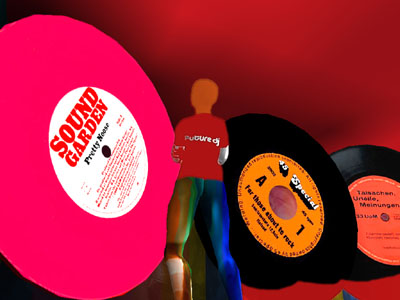
From Postvinyl by Mathias Fuchs.
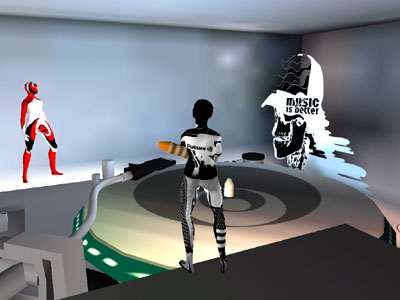
From Postvinyl by Mathias Fuchs.
This game – post-vinyl – plays the game of hybridization on two levels. On a hardware level it is a hybrid of a digital computer with analogue sound modifications, content wise it is a hybrid of an exploratory 3D shooter with the tunnels and corridors of a DJ performance set-up. The users have to slip into the role of a virtual DJ who can start and stop vinyl records by jumping on the record players, picking up records and placing them on turntables. The users can also look for custom-built sound guns, i.e. weapons that allow for the placement of spatialized sound sources in the performance environment. In this regard, the game once more cannibalizes commercial mainstream games: the concept of the weapon is taken up and transformed into a musical instrument.
A Short History of Game Art
In recent years, games have caught the eye of the art community at large, opening a new channel for the future of games in art, as presented by artists using new media and museums. The exhibitions re:play and synreal , the former at the Barbican Centre in London and the latter on a public net-base in Vienna, were amongst the earliest shows presenting games in an artistic context in 1998. Austria-based Ars Electronica, for the first time in its 20-year history, awarded a 2001 Golden Nica prize to an online interactive computer game, Banja , developed by TEAMcHmAn in France. MASS MoCA presented Game Show , a 2001 exhibition and catalogue, aimed to explore how artists are using game structures in their work. The Whitney Museum of American Art presented Bitstreams and Play's the Thing: Critical and Transgressive Practices in Contemporary Art in 2001. Also in 2001, SF MOMA hosted ArtCade: exploring the relationship between Video Games and Art . This two-day event brought together artists, academics, industry pioneers, designers and technologists to discuss the dynamic between games and art. In Europe SELFWARE in Graz, Cultural Capital of Europe in 2001, Spiele von KünstlerInnen in Dortmund and Gameart in Völklingen, started the series of games related art shows, of the first decade of this century, with other shows being prepared like the artgames show, at Ludwig Museum in Aachen, Dec 16 2005 - March 3 2006.
The Kiasma Museum of Contemporary Art in Helsinki, presented Alien Intelligence , which included a mosaic floor mural in the museum entrance, depicting Tomb Raider's Lara Croft, titled Output – 62.500 Materialized Pixels by Arno Coenen & Rene Bosma. Moderna Museet in Stockholm exhibited Museum Meltdow n in 1999 , by Tobias Bernstrup and Palle Torsson, artists inspired by the popular computer game Half-Life . Museum Meltdown immersed museum visitors into a virtual simulation of the Moderna Museet, with selected art objects incorporated as game targets for museum players to destroy.
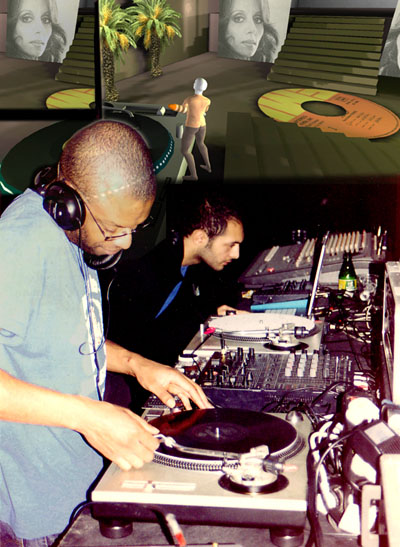
Postvinyl. Andy Odia (left), Olly Farshi (right) live at resfest Vienna
2005. Photo: Mathias Fuchs.
The relationship between commercial games and game art is not without problems. While the arts community continues to explore games as art and cannibalizes on content, concepts and hardware, artistic statements may emerge from game artists which again feed back into the cycles of industrial production and popular media. It seems, however, that there are fundamental differences between games as commodities and art games. The art world seeks to find new media and new platforms of artistic discourse, explore new ways of making art, and also includes a large number of people dedicated to education, criticism and preservation of what has been made to date. Aesthetic innovation through social discourse and examining popular issues are a major driving force in the art community. The game industry, however, is mostly composed of technologically challenged programmers and designers, and exists to attract its audience for the sake of commercialized entertainment. Games are big business, with products produced as unlimited editions, in which the initial monetary value of the best selling game is higher than the value of the most successful, editioned, contemporary artwork sold today. The size of the audience is significantly larger for one game than for the edition of one artwork. Yet the diversity of people being active in the art world and studying art as a profession, might provide space for a completely new audience for games, an audience interested in a multitude of different media, other art forms, history, gender, ethnic and age-related questions. This would be a new gaming community equipped with a high degree of creativity and a keen awareness of social responsibility and aesthetic innovation.
Mathias Fuchs is a musician and media critic, living and working in Manchester U.K. He is currently programme leader of MSc Creative Games and MA Creative Technology in Manchester.
Read more about Mathias here.
|
 |
|